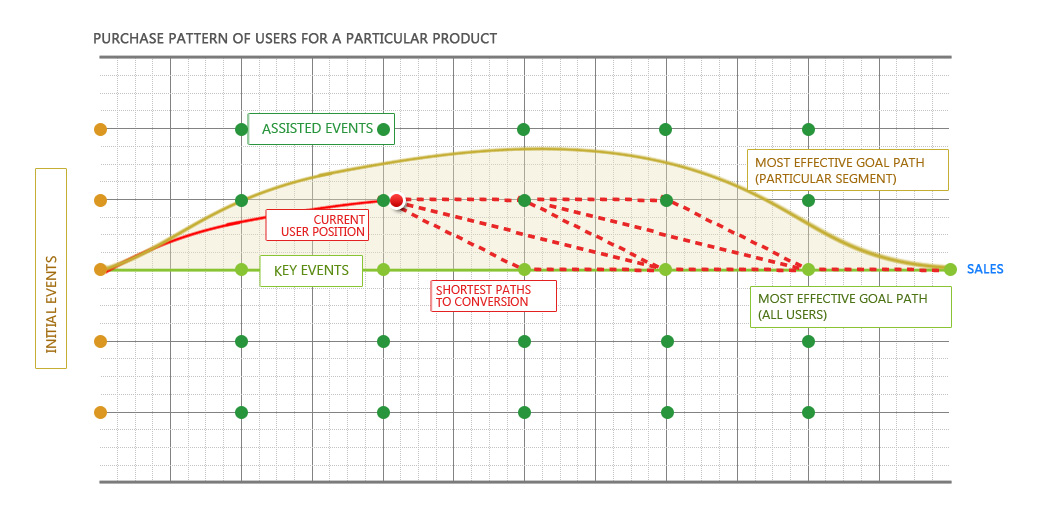In order to measure ROI on Ad Spends(ROAS), it is important to track the entire journey of the ad visitor up to the point of purchase. This could happen either on their first visit or during subsequent visits. Measuring conversions, or measuring interest generated by a particular ad, is dependent on the interactions that happen post clicking the ad. By filtering out bot traffic, one can identify the right channel that drives visitors with intent.
To successfully measure your ad visitors to this level, you will need to track visitor interactions of every session across all channels until a purchase is made. This helps in measuring channel effectiveness based on individual interactions and arriving at an accurate conversion rate for each channel.
For example:
If there were 10 unique visitors from the Facebook Ad Campaign, and 3 of them resulted in deeper browsing behavior (in contrast to the 7 single page visits), the marketer can immediately identify the effectiveness of the campaign and fine-tune their targeting parameters to improve the quality of ad visitors. They can also set triggers to engage the visitors with a higher propensity, in order to drive them towards the lead conversion goals.
By measuring interactions, one can bring down the costs (spent on unqualified leads) and also engage and convert the visitor, thereby increasing customer conversion. Both these parameters are responsible for decreasing customer acquisition costs.
In case of the above example, let’s say your Facebook cost-per-click was $1. You would’ve spent $10 to get 10 unique visitors, out of which 7 visitors($7) bounced out. The remaining 3 visitors($3), if not engaged or converted to lead, might not come back, losing out on the remaining $3.
To avoid visitors drifting away, the marketer needs to have a strategy in place to collect their email or phone number. You can then reconnect with them over email or SMS, and communicate with them based on their preferences. This allows the marketer to advertise over other contactable channels( far cheaper) like Email, SMS, Push Notifications, Browser Notifications or Social Inboxes and drive traffic back to their shop, website or app.
Unlike traditional CAC measurement, it is important to measure:
- costs incurred on advertising to get traffic
- costs incurred on driving this traffic towards a purchase goal.

Simply measuring campaigns against purchases will not reveal the true customer acquisition cost. There are multiple factors like repeat purchases, direct visits, and others that need to be filtered out.
For example:
A visitor coming from a Facebook campaign ($1) registered and added a product to the cart but did not buy it. It took the marketer about 10 follow-up promotional messages to finally convert to purchase. Here the total acquisition cost would be a sum of the campaign and its follow-ups to the point of purchase.
After calculating unit CAC over each user, and clustering them by channels, we can arrive at the average customer acquisition cost (CAC) per channel. These costs, when rolled up, will give you the average customer acquisition cost.
There could be scenarios where a channel influences the user path to purchase but does not act as the main attributor. The probabilistic attribution model extracts every single influence and weights up based on its degree of influence. This allows for understanding the actual conversion rate of a channel. This will allow the marketer to understand which channels drive more conversion and the conversion metric can be used to deduce the max bid price for that channel.
For example:
Let’s say you want to run a campaign on Facebook/Google and the bid price for a particular product keyword is “X”. You also know that these channels deliver 15% conversion. For every 100 visitors, 15 people are likely to buy the product. If the product margin was $2 and if the 100 visitors cost $35, then converting 15 visitors would generate only $30. So working backward, marketers can arrive at the max bid price and then plan their campaign budget to ensure profitable campaigns.
The key to managing campaign budgets is to have ad platforms and marketing data tightly integrated. This will ensure that there is a seamless measurement of user(n:1) actions across platforms and will provide a learning-based environment for automating smart ad targeting.
Plumb5, which stores data by single visitor/customer, tracks from the point a visitor clicks the ad to the point of purchase. By integrating with platforms like MediaMath, Lotame, and others, Plumb5 syncs up with the audience profiles on these platforms.
When an ad is served on any network through a DSP, the user who clicks the ad is resolved when they land on the website or the app. Using audience profile parameters, a targeted engagement on the website/app is triggered. Subsequently, an event trail is created for each visitor which covers every visit and their responses to follow-ups. Thus, the entire journey of a user upto the point of purchase is revealed.
Plumb5 Conversion Automation allows marketers to set rules and segments and run automated targeted campaigns to the hordes of new visitors driven by your ad campaign.
To summarize, Plumb5 is the right fit to optimize your ad spends and acquire more customers with personalized and contextual engagement, bringing more value to your ad investments.

